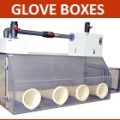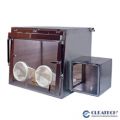How Vacuum Glove Box Works?
A vacuum glove box (VGB) is a chamber with a clear top and double walls that has been evacuated (pressurized to nearly absolute vacuum conditions), and sealed.
Vacuum Glove Boxes are used for a wide variety of chemical and biological laboratory manipulations including: Solutions and suspensions: biochemical reactions, filtration, heating, cooling, mixing; Solid and porous material: reactions and extraction; Liquids: injections and cooling; Solids: holding, grinding, sandblasting etc.
The most jobs of the vacuum glove box involve handling materials that react with moisture in the ambient atmosphere, such as water or steam. Other applications of Vacuum Glove Boxes include testing the micro-biological containment performance of barrier materials such as seals, gloves and surgical gowns.
What are the benefits of Vacuum glove Box?
Vacuum glove boxes are the ideal choice for a wide range of applications, including:
- The inertness of the glove box and its contents are not compromised by the presence of oxygen, and so the contents of the glove box can be used for reactions which otherwise would have been impossible due to the presence of oxygen.
- The inertness of the glove box contents allows for safe handling of hazardous substances and their use in safety critical situations.
- The glove box contents are isolated from ambient air, thereby preventing contamination from the ambient air.
- Inertness and sealing properties of the glove box allow for easy and efficient filtration of hazardous materials.
- Inertness and sealing properties of the glove box allow for the preparation of reagents in the glove box and its use as a reaction chamber.
- The glove box contents can be maintained at temperatures well below the boiling point of water.
- High thermal stability of the glove box materials.
- Inertness of the glove box materials prevents moisture from affecting the contents of the glove box.
- The glove box contents can be sealed against the outside atmosphere for long periods of time without degradation of the glove box materials.
- The glove box contents can be flushed with inert gas for efficient cleaning.
- The glove box can be flushed with inert gas for cleaning of its contents.
- The glove box can be flushed with inert gas for efficient flushing of its contents.
- The glove box can be flushed with inert gas for cleaning of the outside surface of its contents.
- Inertness of the glove box materials prevents the degradation of the glove box contents.
- Inertness of the glove box materials prevents the formation of toxic gases inside the glove box.
- The glove box can be flushed with inert gas for efficient flushing of its contents.
- The glove box contents can be flushed with inert gas for cleaning of its inside surface.
- The glove box can be flushed with inert gas for efficient flushing of its contents.
- The glove box contents can be flushed with inert gas for cleaning of its outside surface.
- The glove box can be flushed with inert gas for efficient flushing of its contents.
- Inertness of the glove box materials prevents the formation of toxic gases inside the glove box.
- Inertness of the glove box materials prevents the degradation of the glove box contents.
- The glove box can be flushed with inert gas for efficient flushing of its contents.
- The glove box contents can be flushed with inert gas for cleaning of its inside surface.
- The glove box contents can be flushed with inert gas for efficient flushing of its outside surface.
How it works?
When the vacuum is turned on, the pressure in the glove box will be less than 1/10 of the ambient pressure, which is about 1 atmosphere.
The inside of the glove box is connected to a vacuum pump, which will pull air molecules out of the glove box and into the pump.
The vacuum pump will be connected to a vacuum gauge, which will show the pressure inside the glove box to be less than 1/10 of the ambient pressure.
The vacuum gauge will show the pressure in the glove box to be 1/10 of the ambient pressure.
The pressure inside the glove box will be lower than the pressure inside the glove box, which is 1/10 of the ambient pressure.
Original Source: https://articlescad.com/how-vacuum-glove-box-works-35165.html







